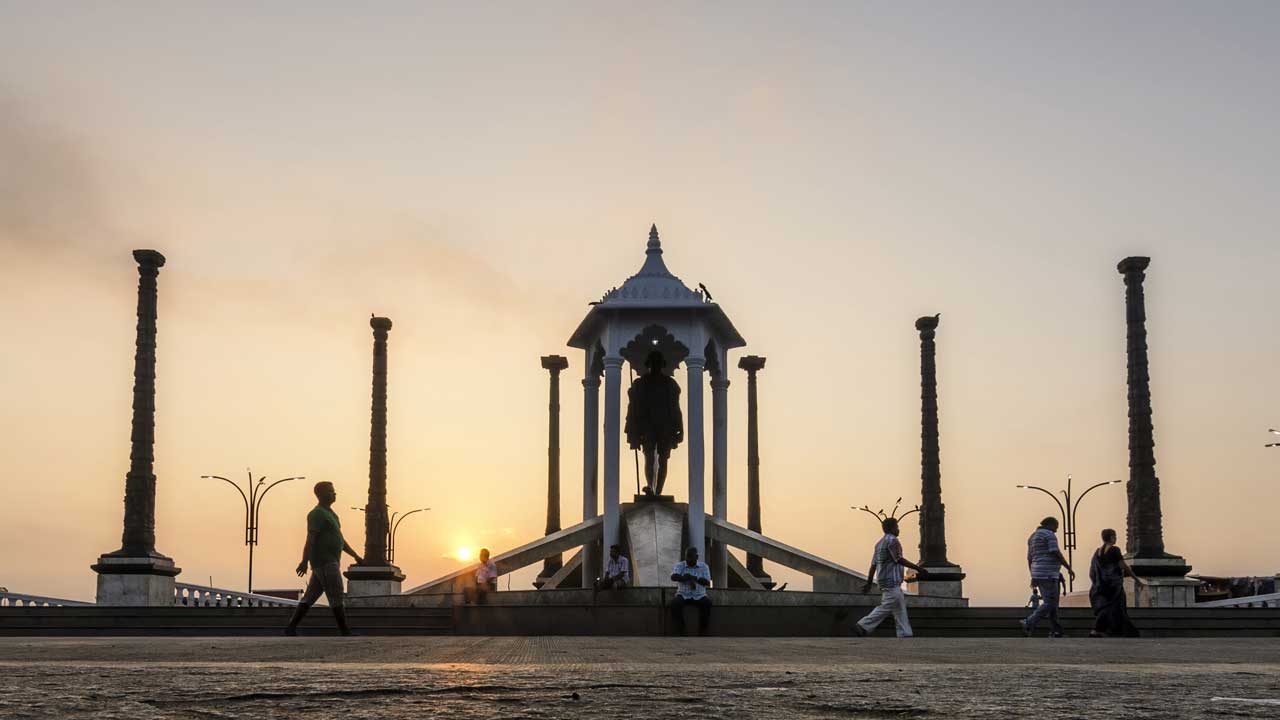The name Pondicherry has been derived from the Tamil word Puducheri signifying ‘the new settlement’. It was a French settlement that comprised Pondy, Yanam, Karaikal, and Mahe. Amazing is the fact that different districts of Pondicherry fall under different states. The capital Pondicherry is situated in the state of Tamil Nadu at a distance of around 200 km from Chennai. While Karaikal is also a part of Tamil Nadu, Mahe is located in Kerala, and Yanam is in Andhra Pradesh. There is a strong influence of French culture on Pondicherry town, especially on it’s architecture, a result of the centuries-old relations this place maintained with France. Today, Pondicherry is more famous because of its relation with Sri Aurobindo. Sri Aurobindo selected this peaceful and harmonious place to make his abode in the second decade of this century and remained there till his death. A political revolutionary before coming to Pondicherry, he became one of the most famous sages of modern times produced by India.
SRI AUROBINDO ASHRAM
Founded in 1926, the Sri Aurobindo Ashram has grown, under the Mother’s guidance, from a small group of two dozen disciples into a large diversified community with almost 1200 members. Counting the 400 students of the Centre of Education and the hundreds of devotees who live nearby, the larger ashram community consists of more than 2000 people.
Situated in a busy city of over 700,000 people, the Ashram is not a quiet place of retreat but a vibrant centre of life in a modern urban setting. The dynamic character of the community reflects the life-affirming aim of Sri Aurobindo’s Yoga. Work as an offering to the Divine is an essential aspect of the Yoga, and all Ashramites do a certain amount of productive work each day in one or another of the Ashram’s departments.
In the sadhana or spiritual discipline at the Ashram, there are no obligatory practices, no rituals, no compulsory meditations or systematic instructions in Yoga. Sadhaks are left free to determine the course and pace of their sadhana in accordance with their own natures. But the general principle of the sadhana is the same for all: there must be a surrender to the Divine and an opening to the Divine Force so that it may work to transform one’s being.
The Ashram is located in the eastern part of Pondicherry. Ashramites live and work in a large number of buildings spread throughout the area. The focus of community life is the Ashram main building, usually called simply “the Ashram”, which consists of an interconnected block of houses, including those in which Sri Aurobindo and the Mother lived for most of their lives. At its centre, in a tree-shaded courtyard, lies the Samadhi, a white-marble shrine where their bodies are laid to rest.
The Ashram provides its members with all they need for a decent and healthy life. Various departments have been organised to look after the basic requirements of food, clothing and shelter, as well as medical care. The Ashram has farms and gardens, a printing press and a number of small-scale industries. There are also libraries for study and facilities for a variety of cultural pursuits.
The History of Pondicherry
Not much is known about Pondicherry before the foreign settlement started. There are evidences of the Pallava, Chola and the Vijayanagar empires around the city. What is interesting are the relics of Arekmedu, the famous archaeological city with a port through which major trade was conducted with the Roman Empire. It is through this port that India used to export silk, spices, even birds, lions, elephants to the Roman Empire in exchange for gold.”
In the 16th century, the Portuguese first arrived here and then the following century the Danes made an appearance. In 1673, the French arrived. Till then, Pondicherry was a weaving and fishing village. The French quarters started along the sea and extended to the south, all along the sea. The city slowly emerged with the fort at its center. The town planners tried to implement this grid system methodically. It required the reconstruction of many houses, mostly those of the Tamilians. It also required the strict implementation of regulations. In all, it took the French almost a century to implement the plan-that of the present concentric pattern with the fort at the center and boulevards surrounding it. It has, however, expanded beyond the boulevard in recent years.
Today, some adjacent areas, which were previously villages, have been included within the city limits. Around the 1760’s, the British destroyed the city including the fort. When the French reoccupied it, most of the buildings were reconstructed but not the fort.
In the latter part of the 18th and early 19th century, Pondicherry again fell into British hands and all construction activity came to a standstill. Most of the present day buildings came up in the 19th century, which also marked the advent of water supply in the city and the railway link with British India. By the 20th century, the city had expanded to include many neighboring villages, although few changes were made in the inner city.
This French colony became a part of the Indian Union in the early 1950’s, with the French voluntarily relinquishing control.
Today, the Union Territory of Pondicherry includes the other three French enclaves of Karaikal (in Tamil Nadu), Mahe (in Kerala) and Yanam (in Andhra Pradesh).
Facts & Figures of Pondicherry
Area : 492 Sq Km
Population : 973,829 (2001)
Religion : Hinduism , Christianity and Islam
Annual Rainfall : 993.4 Degree Centigrade
Temperature : Max(31.90 Degree Centigrade) Min ( 24.50 Degree Centigrade)
Capital: Pondicherry
Languages : Tamil , Malayalam and Telgu.
Literacy Rate : 81.49 %
Per Capita Income : 11,677 (1997-98)
Best Time to Visit : March to October
How to Reach Pondicherry
By Air: Nearest airport from Pondicherry is Chennai 162 km. One can take flights for most of the important Indian cities many places abroad Chennai International Airport.
By Rail: Pondicherry is connected through a meter gauge railway line with Villupuram. There is only one railway station between Pondicherry and Villupuram i.e. Villianur. Most people generally do not prefer trains and take buses instead.
By Road: Pondicherry is well connected to most of the major towns of southern India by road. Buses ply between Pondicherry and Chennai regularly as well as for other important cities of this region.





